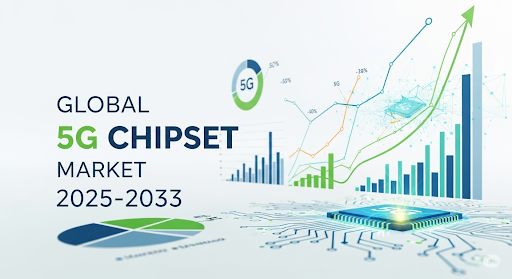
The global 5G chipset market is experiencing robust growth, driven by escalating demand for high-speed internet and advanced data services across various sectors. In 2024, the market reached a valuation of USD 7.9 billion and is projected to soar to USD 85.4 billion by 2033, reflecting a compound annual growth rate (CAGR) of 30.2% during 2025-2033. Key factors propelling this growth include the widespread adoption of IoT devices, significant investments in 5G network deployment, and supportive government policies. Notably, the Asia-Pacific region holds the largest market share, attributed to rapid network deployment and government support.
STUDY ASSUMPTION YEARS
- Base Year: 2024
- Historical Years: 2019-2024
- Forecast Years: 2025-2033
5G CHIPSET MARKET KEY TAKEAWAYS
- Market Size and Growth: The global 5G chipset market was valued at USD 7.9 billion in 2024 and is anticipated to reach USD 85.4 billion by 2033, growing at a CAGR of 30.2% during 2025-2033.
- Regional Dominance: Asia-Pacific leads the market, with countries like China and South Korea at the forefront due to rapid 5G network deployment and supportive government initiatives.
- Technological Advancements: The integration of 5G chipsets in consumer electronics, especially smartphones, and the industrial automation sectors is a significant trend enhancing market growth.
- IoT and Smart Cities: The proliferation of IoT devices and smart city initiatives are contributing to the increased demand for 5G chipsets.
- Energy-Efficient Solutions: The introduction of energy-efficient and cost-effective chipset solutions is creating a positive outlook for the market.
- Government Support: Substantial investments and supportive policies from governments worldwide are facilitating the expansion of 5G infrastructure.
MARKET GROWTH FACTORS
- Rising Demand in Consumer Electronics
The rise of smartphones, tablets, and wearables is really pushing the 5G chipset market forward. Nowadays, consumer electronics are increasingly relying on Application-Specific Integrated Circuits (ASICs) and RFICs to keep up with the demand for faster data speeds. With devices that support Sub 6 GHz and 26–39 GHz bands, manufacturers are focused on delivering better connectivity, lower latency, and greater reliability. The growing popularity of gaming, streaming, and smart devices is driving the adoption of these chipsets. Ultimately, users want a seamless high-speed internet experience. Insights into how these chipsets work show that they optimize frequency allocation, manage signal processing, and improve power efficiency. The trend is clear: we’re seeing miniaturized, energy-efficient chips designed for mobile devices. Today, 5G chipsets have become standard in high-end devices, significantly enhancing user experience and network efficiency.
- Expansion in Automotive & Transportation
The rise of autonomous vehicles, connected cars, and smart transport systems is driving the growth of 5G chipsets. Key players like FPGA and Millimeter Wave Technology Chips are essential for vehicle-to-everything (V2X) communication and processing data in real-time. The Sub 6 GHz frequency provides extensive coverage, while frequencies above 39 GHz enable rapid data transfer for sensors and AI systems. Users are particularly focused on safety, navigation, and entertainment features. Insights into the mechanisms reveal low-latency signal transmission, vehicle-to-vehicle data sharing, and effective bandwidth management. A notable trend is the integration of AI-driven transport solutions. The market is expanding thanks to the rising adoption of electric vehicles (EVs), supportive government initiatives, and the development of smart city infrastructure that demands reliable 5G connectivity.
- Industrial Automation Growth
Factories are now embracing 5G chipsets to enhance automation, connect IoT devices, and enable real-time monitoring. With the help of ASICs and RFICs, machines can communicate with each other, allowing for predictive maintenance and the use of smart robotics. Operating within a frequency range of 26–39 GHz, these technologies ensure low latency and high reliability in industrial settings. The goal for end-users is to boost efficiency, productivity, and safety. Insights into these mechanisms reveal that chipsets effectively manage real-time data transfer, process control, and network slicing. A notable trend is the rise of industrial 5G solutions integrated with AI. Adoption is on the rise, fueled by Industry 4.0 initiatives that aim to minimize downtime and facilitate remote monitoring. The market is being propelled forward by the global shift towards smart factories and automation upgrades.
Request for a sample copy of this report:
https://www.imarcgroup.com/5g-chipset-market/requestsample
MARKET SEGMENTATION
Breakup by Chipset Type:
- Application-Specific Integrated Circuits (ASIC): Custom-designed chips optimized for specific applications, offering high performance and efficiency in 5G devices.
- Radio Frequency Integrated Circuit (RFIC): Chips that handle radio frequency signals, essential for wireless communication in 5G networks.
- Millimeter Wave Technology Chips: Chips operating at high-frequency bands, enabling ultra-fast data transmission in 5G networks.
- Field-Programmable Gate Array (FPGA): Reconfigurable chips that can be programmed post-manufacturing, offering flexibility in 5G applications.
Breakup by Operational Frequency:
- Sub 6 GHz: Frequency bands below 6 GHz, providing broad coverage and reliable connectivity in 5G networks.
- Between 26 and 39 GHz: High-frequency bands offering faster data rates and lower latency, suitable for dense urban areas.
- Above 39 GHz: Extremely high-frequency bands enabling ultra-high-speed data transmission over short distances.
Breakup by End User:
- Consumer Electronics: Devices like smartphones and tablets that utilize 5G chipsets for enhanced connectivity and performance.
- Industrial Automation: Manufacturing and industrial processes leveraging 5G for real-time monitoring and control.
- Automotive and Transportation: Vehicles and transportation systems integrating 5G for improved communication and automation.
- Energy and Utilities: Energy sector applications using 5G for smart grid management and efficient resource distribution.
- Healthcare: Medical devices and telemedicine services employing 5G for real-time data transmission and remote consultations.
- Retail: Retail operations utilizing 5G for enhanced customer experiences and efficient inventory management.
- Others: Additional sectors adopting 5G technology for various applications.
Breakup by Region:
- North America (United States, Canada)
- Asia Pacific (China, Japan, India, South Korea, Australia, Indonesia, Others)
- Europe (Germany, France, United Kingdom, Italy, Spain, Russia, Others)
- Latin America (Brazil, Mexico, Others)
- Middle East and Africa
REGIONAL INSIGHTS
When it comes to the global 5G chipset market, the Asia-Pacific region is really leading the charge, fueled by the rapid deployment of 5G networks and strong support from governments. Nations like China and South Korea are at the forefront of 5G adoption, investing heavily in infrastructure and creating favorable policies. This forward-thinking approach has resulted in a high number of 5G-enabled devices and services, firmly establishing the region as a market leader.
RECENT DEVELOPMENTS & NEWS
The latest trends in the 5G chipset market reveal an exciting surge in the use of 5G technology within consumer electronics, particularly smartphones, and in various commercial sectors like IoT and industrial automation. The arrival of energy-efficient and cost-effective chipset solutions is setting a positive tone for the future of the 5G chipset market. These advancements highlight the market’s lively nature and its quick response to tech progress and consumer preferences.
Key Players
Broadcom Inc, Huawei Technologies Co., Ltd., Infineon Technologies Ag, Intel Corporation, Mediatek Inc, Nokia Corporation, Qorvo, Qualcomm Technologies, Inc., Samsung Electronics Co. Ltd., Xilinx Inc, etc.
Ask Analyst for Customization:
https://www.imarcgroup.com/request?type=report&id=5326&flag=C
If you require any specific information that is not covered currently within the scope of the report, we will provide the same as part of the customization.
About Us:
IMARC Group is a global management consulting firm that helps the world’s most ambitious changemakers to create a lasting impact. The company provides a comprehensive suite of market entry and expansion services. IMARC offerings include a thorough market assessment, feasibility studies, company incorporation assistance, factory setup support, regulatory approvals and licensing navigation, branding, marketing and sales strategies, competitive landscape, and benchmarking analyses, pricing and cost research, and procurement research.
Contact Us:
IMARC Group
134 N 4th St. Brooklyn, NY 11249, USA
Email: sales@imarcgroup.com
Tel No:(D) +91 120 433 0800
United States: (+1-201971-6302)






